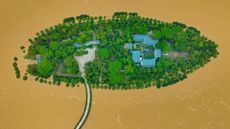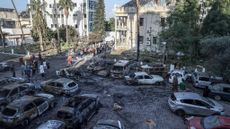Iran protests: why the unrest is spreading
At least 22 people are reported dead and hundreds have been arrested in the biggest challenge to the regime in years

Iran’s clerical and political leaders are facing the biggest challenge to their authority in almost a decade, after a fifth day of street protests.
According to state media, at least 22 people have been killed, nine of them last night, and hundreds arrested following anti-government demonstrations in more than 40 towns and cities across Iran in the past week. A police officer was reportedly shot dead overnight in the central city of Najafabad.
Largely spontaneous, the protests have stemmed from concerns about rising living costs, unemployment, rampant corruption and a stagnant economy, “but have developed into a broader-based outcry against the regime”, says CNN.
Subscribe to The Week
Escape your echo chamber. Get the facts behind the news, plus analysis from multiple perspectives.

Sign up for The Week's Free Newsletters
From our morning news briefing to a weekly Good News Newsletter, get the best of The Week delivered directly to your inbox.
From our morning news briefing to a weekly Good News Newsletter, get the best of The Week delivered directly to your inbox.
Writing for the broadcaster, Trita Parsi, president of the National Iranian American Council, says the protests may have started as a reaction to the spluttering economy but now “there is something larger at play”.
The Independent says tens of thousands of people have taken to the streets and security forces have had to fight off armed protesters trying to take over police stations and military bases.
Yesterday was the deadliest day yet, despite a call for calm from Iran’s president. Addressing a meeting of Iranian MPs, Hassan Rouhani played down the significance of the demonstrations and said compared to similar incidents in the past they were “nothing”.
“People are completely free in criticising [the government] or protesting, but criticism is different from violence and destroying property,” he said. “The government will definitely not tolerate any destruction of public property or social order.”
Rouhani and other senior politicians have been “rattled” by the biggest expression of public discontent since the so-called Green Movement of 2009, says the Financial Times, when millions marched in the capital to protest the re-election of President Mahmoud Ahmadinejad, in a ballot the opposition said was rigged.
Various media outlets have reported attempts by the government to block social media apps such as the encrypted messaging service Telegram, which is used by 80 million Iranians. Donald Trump condemned efforts to crack down on dissent on social media, sparking a war of words between the US president and Rouhani.
Perhaps more worrying for Iran’s leaders are reports of posters of Ayatollah Khamenei, the country’s supreme leader, being torn down and burnt “in an act of defiance that strikes at the heart of the Islamic Republic”, says The Times.
Rouhani, who won a landslide election in May on a reformist agenda, promised the economy would improve after the 2015 nuclear agreement eased tough international sanctions, “but many Iranians say they haven’t reaped the benefits”, says the Los Angeles Times. According to the BBC Persian service, the average Iranian has become 15% poorer in the past ten years.
There is disagreement over who started the demonstrations, and who is leading them now. “Reformist politicians and analysts said the protests were initially organised by hardliners to undermine Rouhani’s centrist government,” reports the Financial Times. The LA Times, however, says the demonstrators have quickly turned against the hardliners, led by Khamenei, blamed by many for blocking economic reforms while tolerating corruption and funding Shiite militias abroad.
Despite the outpouring of anger, “the protests have remained confined to relatively small pockets of mostly young male demonstrators who are demanding the overthrow of the clerical regime” and who lack coordinated leadership, says the BBC’s Kasra Naji.
Some protesters have been calling for the return of the monarchy which was toppled in the Iranian Revolution in 1979. The former Shah’s son, Reza Pahlavi, who lives in exile in the US, has issued a statement supporting the demonstrations “but there are signs that he is as much in the dark about where these protests are going as anyone else”, says the BBC.
Create an account with the same email registered to your subscription to unlock access.
Sign up for Today's Best Articles in your inbox
A free daily email with the biggest news stories of the day – and the best features from TheWeek.com
-
 The week's best photos
The week's best photosIn Pictures A flooded island, a ballistic missile, and more
By Anahi Valenzuela, The Week US Published
-
 Who actually needs life insurance?
Who actually needs life insurance?The Explainer If you have kids or are worried about passing on debt, the added security may be worth it
By Becca Stanek, The Week US Published
-
 Sexual wellness trends to know, from products and therapies to retreats and hotels
Sexual wellness trends to know, from products and therapies to retreats and hotelsThe Week Recommends Talking about pleasure and sexual health is becoming less taboo
By Theara Coleman, The Week US Published
-
 Puffed rice and yoga: inside the collapsed tunnel where Indian workers await rescue
Puffed rice and yoga: inside the collapsed tunnel where Indian workers await rescueSpeed Read Workers trapped in collapsed tunnel are suffering from dysentery and anxiety over their rescue
By Sorcha Bradley, The Week UK Published
-
 Gaza hospital blast: What the video evidence shows about who's to blame
Gaza hospital blast: What the video evidence shows about who's to blameSpeed Read Nobody wants to take responsibility for the deadly explosion in the courtyard of Gaza's al-Ahli Hospital. Roll the tape.
By Peter Weber, The Week US Published
-
 Giraffe poo seized after woman wanted to use it to make a necklace
Giraffe poo seized after woman wanted to use it to make a necklaceTall Tales And other stories from the stranger side of life
By Chas Newkey-Burden, The Week UK Published
-
 Helicopter sound arouses crocodiles
Helicopter sound arouses crocodilesTall Tales And other stories from the stranger side of life
By Chas Newkey-Burden, The Week UK Published
-
 Woman sues Disney over 'injurious wedgie'
Woman sues Disney over 'injurious wedgie'Tall Tales And other stories from the stranger side of life
By Chas Newkey-Burden, The Week UK Published
-
 Emotional support alligator turned away from baseball stadium
Emotional support alligator turned away from baseball stadiumTall Tales And other stories from the stranger side of life
By Chas Newkey-Burden, The Week UK Published
-
 Europe's oldest shoes found in Spanish caves
Europe's oldest shoes found in Spanish cavesTall Tales And other stories from the stranger side of life
By Chas Newkey-Burden, The Week UK Published
-
 Artworks stolen by Nazis returned to heirs of cabaret performer
Artworks stolen by Nazis returned to heirs of cabaret performerIt wasn't all bad Good news stories from the past seven days
By The Week Staff Published